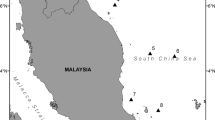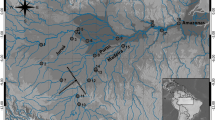Abstract
The shovelnose guitarfish Rhinobatos productus is an evolutionarily, ecologically, and economically important ray, with a continuous distribution from San Francisco, California (USA), to Mazatlan, Sinaloa, and in the Gulf of California (Mexico). Regional studies have revealed morphometric differences between shovelnose from the Gulf of California and the Pacific coast of Baja California, which may result from phenotypic plasticity in the presence of high levels of gene flow or from a degree of genetic differentiation in the presence of cryptic isolation within a continuous distribution. We used PCR-RFLP of the mitochondrial control region to assess the degree of genetic differentiation between Gulf of California and Pacific shovelnose guitarfish. We found very high levels of molecular diversity (averages: h=0.77, π=1.19%), which may be associated with historically large and stable populations, as well as very significant levels of genetic differentiation between gulf and Pacific samples (χ 2=64, P<0.0001; Φ ST=0.63, P<0.0001, mean nucleotide divergence d=2.47%). We found a deep phylogeographic break between haplotypes from the gulf and the Pacific, which may suggest the existence of cryptic species but clearly indicates more than one evolutionarily significant unit of R. productus. Our results show a pattern of genetic structure and levels of differentiation consistent with the geological history of the region. Furthermore, these findings have wide-ranging implications for the management and conservation of cartilaginous fish in Mexico, as they reveal the existence of biological diversity that will go unnoticed without the genetic scrutiny of intraspecific variation and that is highly relevant for much needed management and conservation efforts.

Similar content being viewed by others
References
Atkinson D (1994) Temperature and organism size: a biological law for ectotherms? Adv Ecol Res 25:1–58
Avise JC, Neigel JE, Arnold J (1984) Demographic influences on mitochondrial DNA lineage survivorship in animal populations. J Mol Evol 20:99–105
Avise JC, Arnold J, Ball RM, Bermingham E, Lamb T, Neigel JE, Reeb CA, Saunders NC (1987) Intraspecific phylogeography: the mitochondrial DNA bridge between population genetics and systematics. Annu Rev Ecol Syst 18:489–522
Beeve W, Tee-Van J (1941) Eastern Pacific expeditions of the New York Zoological Society, vol XXVIII. Fishes from tropical eastern Pacific, part 3. Ray, mantas and chimeras. Zool J Linn Soc 26:245–280
Bernardi G, Findley L, Rocha-Olivares A (2003) Vicariance and dispersal across Baja California in disjunct marine fish populations. Evolution 57:1599–1609
Bowen BW, Grant WS (1997) Phylogeography of the sardines (Sardinops spp.): assessing biogeographic models and population histories in temperate upwelling zones. Evolution 51:1601–1610
Brown ME (1957) Experimental studies on growth. In: Brown ME (ed) The physiology of fishes. Academic, New York, pp 361–400
Carlson JK (1997) Age and growth of the bonnethead shark, Sphyrna tiburo, from northwest Florida, with comments on clinal variation. Environ Biol Fishes 50:331–341
Cockerham CC, Weir BS (1993) Estimation of gene flow from F-statistics. Evolution 47:855–863
Compagno L (1977) Phyletic relationships of living sharks and rays. Am Zool 17:303–322
Dawson EY (1960) A review of the ecology, distribution, and affinities of the benthic flora. Syst Zool 9:93–100
Dubois AJ (1981) Studies on fishes in Mugu Lagoon, California. M.A. thesis, University of California Santa Barbara, Santa Barbara
Endler JA (1989) Conceptual and other problems in speciation. In: Otte D, Endler JA (eds) Speciation and its consequences. Sinauer, Sunderland, Mass., pp 625–648
Excoffier L, Smouse PE, Quattro JM (1992) Analysis of molecular variance inferred from metric distances among DNA haplotypes: application to human mitochondrial DNA restriction data. Genetics 131:479–491
Feldheim KA, Gruber SH, Ashley MV (2001) Population genetic structure of the lemon shark (Negaprion brevirostris) in the western Atlantic: DNA microsatellite variation. Mol Ecol 10:295–303
Grant WS, Bowen BW (1998) Shallow population histories in deep evolutionary lineages of marine fishes: insights from sardines and anchovies and lessons for conservation. J Hered 89:415–426
Grijalva-Chon JM, Kaichi A, Numachi K (2002) Homogeneidad genética en tiburón angelito (Squatina californica) del Golfo de California, evidencia por análisis PCR-RFLP de la región control del ADN mitocondrial. Cienc Mar 17:37–42
Heist EJ (1999) A review of population genetics in sharks. Am Fish Soc Symp 23:161–168
Heist EJ, Musick JA, Graves JE (1996a) Genetic population structure of the shortfin mako (Isurus oxyrinchus) inferred from restriction fragment length polymorphism analysis of mitochondrial DNA. Can J Fish Aquat Sci 53:583–588
Heist EJ, Musick JA, Graves JE (1996b) Mitochondrial DNA diversity and divergence among sharpnose sharks, Rhizoprionodon terraenovae, from the Gulf of Mexico and Mid-Atlantic Bight. Fish Bull (Wash DC) 94:664–668
Holt JW, Holt EW, Stock JM (2000) An age constraint on Gulf of California rifting from the Santa Rosalía basin, Baja California Sur, Mexico. Geol Soc Am Bull 112:540–549
Howard DJ, Berlocher SH (1998) Endless forms: species and speciation. Oxford University Press, New York
Huang D, Bernardi G (2001) Disjunct sea of Cortez–Pacific Ocean Gillichthys mirabilis populations and the evolutionary origin of their Sea of Cortez endemic relative, Gillichthys seta. Mar Biol 138:421–428
Imsland AK, Sunde LM, Folkvord A, Stefansson SO (1995) The interaction of temperature and fish size on growth of juvenile turbot. J Fish Biol 49:926–940
Kumar S, Tamura K, Jakobsen IB, Nei M (2001) MEGA 2: molecular evolutionary genetic analysis software. Bioinformatics 17:1244–1245
Larson RL, Menard HW, Smith SM (1968) Gulf of California: a result of ocean-floor spreading and transform faulting. Science 161:781–784
Maluf LY (1983) Physical oceanography. In: Case TJ, Cody ML (eds) Island biogeography of the Sea of Cortez. University of California Press, Berkeley, pp 26–45
Martin AP (1995) Mitochondrial DNA sequence evolution in sharks: rates, patterns, and phylogenetic inferences. Mol Biol Evol 12:1114–1123
Martin AP, Palumbi SR (1993) Body size, metabolic rate, generation time, and the molecular clock. Proc Natl Acad Sci USA 90:4087–4091
McCune AR, Lovejoy NR (1998) The relative rate of sympatric and allopatric speciation in fishes: tests using DNA sequence divergence between sister species and among clades. In: Howard DJ, Berlocher SH (eds) Endless forms: species and speciation. Oxford University Press, New York, pp 172–185
McElroy D, Moran P, Bermingham E, Kornfield I (1992) The restriction enzyme analysis package (REAP). Heredity 83:157–158
Moritz C (1994) Defining evolutionarily significant units for conservation. Trends Ecol Evol 9:373–375
Nei M (1987) Molecular evolutionary genetics. Columbia University Press, New York
Nei M, Li W-H (1979) Mathematical model for studying genetic variation in terms of restriction endonucleases. Proc Natl Acad Sci USA 76:5269–5273
Nei M, Tajima F (1981) DNA polymorphism detectable by restriction endonucleases. Genetics 97:145–163
Nielsen JL, Powers DA (1995) Evolution and the aquatic ecosystem: defining unique units in population conservation. Am Fish Soc Symp 17
Palumbi SR (1992) Marine speciation on a small planet. Trends Ecol Evol 7:114–118
Palumbi SR (1999) The prodigial fish. Nature 402:733–735
Riddle BR, Hafner DJ, Alexander LF, Jaeger JR (2000) Cryptic vicariance in the historical assembly of a Baja California peninsular Desert biota. Proc Natl Acad Sci USA 97:14438–14443
Rocha-Olivares A, Sandoval-Castillo JR (2003) Mitochondrial diversity and genetic structure in allopatric populations of Pacific red snapper Lutjanus peru. Cienc Mar 29:197–209
Roff DA, Bentzen P (1989) The statistical analysis of mitochondrial DNA polymorphisms: χ 2 and the problem of small samples. Mol Biol Evol 6:539–545
Ruzzante DE, Taggart CT, Cook D (1998) A nuclear DNA basis for shelf- and bank-scale population structure in Northwest Atlantic cod (Gadus morhua): Labrador to Georges Bank. Mol Ecol 7:1663–1680
Schneider S, Roessli D, Excoffier L (1999) Arlequin ver. 2.0: a software for population genetic data analysis. Genetics and Biometry Lab, Dept. of Anthropology, University of Geneva, Geneva
Slatkin M (1995) A measure of population subdivision based on microsatellite allele frequencies. Genetics 139:457–462
Stepien CA, Rosenblatt RH, Bargmeyer BA (2001) Phylogeography of the spotted sand bass, Paralabrax maculatofasciatus: divergence of Gulf of California and Pacific coast populations. Evolution 55:1852–1862
Terry A, Bucciarelli G, Bernardi G (2000) Restricted gene flow and incipient speciation in disjunct Pacific Ocean and Sea of Cortez populations of a reef fish species, Girella nigricans. Evolution 54:652–659
Trexler C, Travis J (1990) Phenotypic plasticity in the sailfin molly, Poecilia latipinna (Pisces: Poeciliidae). I. Field experiments. Evolution 44:143–156
Upton DE, Murphy RW (1997) Phylogeny of the side-blotched lizards (Phrynosomatidae: Uta) based on mtDNA sequences: support for midpeninsular seaway in Baja California. Mol Phylogenet Evol 8:104–113
Villavicencio Garayzar CJ (1993) Biología reproductiva de Rhinobatos productus en Bahía Almejas, Baja California Sur, México. Rev Biol Trop 41:777–782
Acknowledgements
We are grateful to UABCS elasmobranch team (EDT) for sample keeping, J. de la Rosa-Vélez (UABC), O. Sosa-Nishizaki, J. Olmos-Soto, A. Licea-Navarro and V. Díaz-Castañeda (CICESE) for access to their facilities, and N. Olivares-Bañuelos for help in laboratory work, and E.J. Heist for comments on the manuscript. This research was supported by grants from CICESE-CIBNOR to A.R.O. and E.B. and CONACYT-I36064-V to A.R.O. All sampling and experiments were performed with strict adherence to Mexican regulations.
Author information
Authors and Affiliations
Corresponding author
Additional information
Communicated by P.W. Sammarco, Chauvin
Rights and permissions
About this article
Cite this article
Sandoval-Castillo, J., Rocha-Olivares, A., Villavicencio-Garayzar, C. et al. Cryptic isolation of Gulf of California shovelnose guitarfish evidenced by mitochondrial DNA. Marine Biology 145, 983–988 (2004). https://doi.org/10.1007/s00227-004-1378-7
Received:
Accepted:
Published:
Issue Date:
DOI: https://doi.org/10.1007/s00227-004-1378-7




